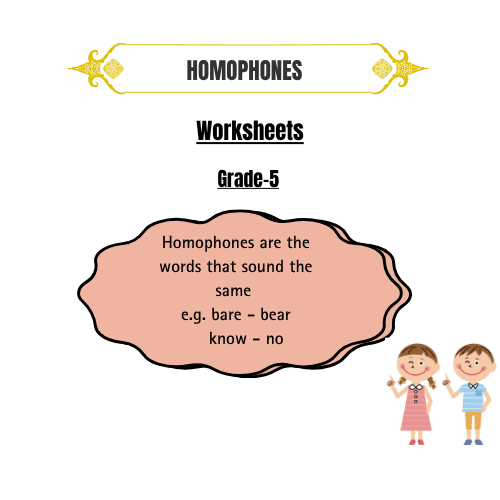Homophones and Homonyms: Meaning, Examples, and Differences

Table of Contents
- What Are Homophones?
- What Are Homonyms?
- Homophones and Homonyms Examples for Better Clarity
- The Difference Between Homophones and Homonyms
- Different Types of Homonyms in Depth
- Commonly Confused Homophones in Daily English
- Advanced Examples of Homonyms in Context
- Teaching Homophones and Homonyms to Kids
- Homophones and Homonyms in Literature
- Real-Life Importance Beyond Classrooms
- Homophones and Homonyms in Different Languages
- Why Students Mix Them Up
- Practical Tips for Parents and Learners
- Why Do Homophones and Homonyms Matter in English?
- Common Mistakes with Homophones and Homonyms
- Tips to Master Homophones and Homonyms
- Homophones and Homonyms in Idioms and Phrases
- Homophones and Homonyms in Technology and Media
- Creative Ways to Practice Homophones and Homonyms
- Homophones and Homonyms in Popular Culture
- Challenges for Non-Native Speakers
- Homophones and Homonyms Exercises for Practice
- Worksheet for Students
- Conclusion
The English language is full of fascinating word pairs that can confuse even fluent speakers. Among them, homophones and homonyms hold a special place because they look or sound similar but have entirely different meanings. These words often lead to mix-ups in writing, reading, and conversations.
If you’ve ever struggled to understand whether a word is a homophone or a homonym, this detailed guide is for you. We will explore the meaning, uses, and clear homophones and homonyms examples to strengthen your understanding. Along the way, we will also uncover the difference between homophones and homonyms so that you never get confused again.
What Are Homophones?
Homophones are words that sound the same but have different spellings and meanings. For example:
Right (correct) and Write (to put words on paper).
Flower (the blossom of a plant) and Flour (powder used in baking).
Homophones are tricky because you cannot tell the meaning just by hearing the word- you must pay attention to spelling and context.
Importance of Learning Homophones
Helps in spelling accuracy.
Improves vocabulary building.
Enhances reading comprehension.
Avoids confusion in written English.
What Are Homonyms?
Homonyms are words that have the same spelling or pronunciation but different meanings.
For example:
Bat (an animal) and Bat (used in cricket).
Bank (financial institution) and Bank (side of a river).
Homonyms are further divided into two types:
Homographs – Words that look the same but may have different meanings. (Lead as a verb vs. Lead as a metal).
Homophones – A subset of homonyms that sound the same but differ in meaning/spelling. (Two, to, too).
Homophones and Homonyms Examples for Better Clarity
Let’s look at some interesting pairs:
Examples of Homophones:
Sea (ocean) – See (to look)
Son (male child) – Sun (the star)
Mail (letters) – Male (gender)
Knight (warrior) – Night (opposite of day)
Examples of Homonyms:
Park – a place to relax / to leave a vehicle
Well – healthy / a source of water
Light – not heavy / brightness
Kind – type / generous
By practicing such homonyms and homophones examples, learners can sharpen their grammar and avoid common English mistakes.
The Difference Between Homophones and Homonyms
Many learners find it challenging to distinguish between these two concepts. Here’s the difference between homophones and homonyms explained simply:
Homophones: Words that sound alike but have different spellings and meanings.
Homonyms: Words that look or sound alike but have different meanings.
Example:
Homophones: Meet (encounter) and Meat (food).
Homonyms: Bark (sound of a dog) and Bark (outer layer of a tree).
In short, homophones are a category within homonyms. Understanding the difference between homonyms and homophones ensures you can use them correctly in speech and writing.
Different Types of Homonyms in Depth
While we touched upon homographs and homophones earlier, let’s dig deeper.
Perfect Homonyms – Words that have the same spelling and pronunciation but completely different meanings.
Example: Ring (a piece of jewelry) / Ring (the sound of a bell).
Homographs – Words that are spelled the same but may or may not sound alike, with different meanings.
Example: Tear (to rip apart) / Tear (a drop from the eye).
Capitonyms – Homonyms that change meaning when capitalized.
Example: Turkey (the country) / turkey (the bird).
Understanding these types makes it easier to see the difference between homonyms and homophones clearly.
Commonly Confused Homophones in Daily English
Here’s a closer look at some pairs most often misused in writing:
Affect vs. Effect
Affect = to influence
Effect = result
Complement vs. Compliment
Complement = completes something
Compliment = praise
Principal vs. Principle
Principal = head of a school
Principle = a rule or law
Stationary vs. Stationery
Stationary = not moving
Stationery = writing materials
Misusing these homophones can drastically change the meaning of a sentence, which is why mastering them is key for students and professionals alike.
Advanced Examples of Homonyms in Context
Homonyms can be tricky because context defines their meaning. Consider these examples:
Bark
The dog’s bark was loud.
The bark of the tree was rough.
Well
She sings well.
The farmer dug a well.
Match
He found a perfect match for his shoes.
They watched a cricket match.
By practicing contextual usage, learners can clearly understand the role of homonyms and homophones in everyday communication.
Teaching Homophones and Homonyms to Kids
Parents and teachers often struggle to make these concepts engaging. Here are some proven strategies:
Visual Aids: Flashcards with pictures (e.g., sun/son, flower/flour).
Storytelling: Create short stories that use pairs of homophones.
Example: “The knight rode at night to protect the castle.”
Games: Crossword puzzles, riddles, and spelling games.
Songs & Rhymes: Fun rhymes that highlight homophones.
Real-Life Connection: Encourage kids to notice these words in books, advertisements, or conversations.
Interactive learning ensures children don’t just memorize but also apply these words effectively.
Homophones and Homonyms in Literature
Great writers have often played with homonyms and homophones to create puns, humor, or double meanings. Shakespeare, in particular, loved wordplay.
For example, in Romeo and Juliet, Mercutio says:
“Ask for me tomorrow, and you shall find me a grave man.”
Here, grave means both serious and literally “in a grave.”
Such clever use of homophones and homonyms adds depth and layers to literature.
Real-Life Importance Beyond Classrooms
Business Communication: Using principal instead of principle in an email could look unprofessional.
Legal Documents: Misunderstanding homonyms like bill (law or invoice) may cause errors.
Technology: AI and speech recognition software often struggle with homophones (two/too/to).
Creative Media: Advertisements and slogans often rely on wordplay. Example: “Eye care you can trust” (play on I care).
Thus, knowing the difference between homophones and homonyms is crucial beyond exams- it’s a lifelong skill.
Homophones and Homonyms in Different Languages
While we often discuss these in English, other languages have similar wordplay:
In French, verre (glass), vert (green), and vers (towards) sound alike, just like English homophones.
In Chinese, many words sound the same due to limited phonetic variations, making homophones very common.
This shows that the concept of homonyms and homophones is universal in languages.
Why Students Mix Them Up
There are three main reasons students confuse these terms:
Sound Similarity: Many homophones are phonetically identical.
Weak Vocabulary: Without strong vocabulary, learners can’t rely on context.
Inconsistent Practice: These are often taught once in school and not revisited.
A structured approach with repeated exposure ensures better retention.
Practical Tips for Parents and Learners
Maintain a Homophones Notebook with pairs listed.
Practice one pair a day in sentences.
Use color coding: blue for homophones, green for homonyms.
Apply them in real conversations at home.
Encourage online quizzes and apps designed for English grammar.
By making it part of daily life, the concepts become second nature.
Why Do Homophones and Homonyms Matter in English?
Better Communication: Using the right word avoids misinterpretation.
Academic Importance: Essential for essays, grammar tests, and comprehension.
Creative Writing: Writers use homonyms and homophones to add humor, puns, and double meanings.
Language Fluency: Helps learners sound natural and accurate.
Common Mistakes with Homophones and Homonyms
Students often confuse these words in spelling and usage. Let’s clear this with examples:
Incorrect: I went to the see.
Correct: I went to the sea.
Incorrect: She will bare the pain.
Correct: She will bear the pain.
By practicing the correct form, you can master english grammar and improve clarity.
Tips to Master Homophones and Homonyms
Read Regularly: Exposure to different words improves recognition.
Use Flashcards: Write pairs of homophones and homonyms for revision.
Practice Writing: Create small sentences using both forms of the word.
Learn in Context: Don’t just memorize- use them in conversations.
Play Word Games: Crossword puzzles and spelling bees can make learning fun.
Homophones and Homonyms in Idioms and Phrases
Homophones and homonyms are not only common in isolated words- they also appear in idioms, proverbs, and popular phrases. Understanding them helps learners grasp subtle meanings in conversations.
“Break the ice” vs. “Brake the car”
Break the ice = to initiate a conversation
Brake the car = to stop a vehicle
“Bear with me” vs. “The bear in the forest”
Bear with me = be patient
Bear = a large animal
“Right as rain” vs. “Write a letter”
Right as rain = perfectly fine
Write a letter = compose a message
Idioms often rely on homophones and homonyms for wordplay. Learners who understand these can easily interpret subtle humor or figurative language in texts.
Homophones and Homonyms in Technology and Media
With the rise of digital communication, homophones and homonyms are increasingly relevant in online writing, social media, and AI-based tools.
Texting and Chat: People often confuse words like your/you’re or there/their/they’re. Correct usage is important for clarity.
Search Engines: Google often autocorrects searches based on homophones. For example, searching for weather might autocorrect whether.
AI Tools: Voice recognition software must interpret homophones accurately. Saying “I need to write a report” versus “I need the right report” demonstrates why context is key.
Being aware of these challenges helps learners communicate effectively in the digital age.
Creative Ways to Practice Homophones and Homonyms
Here are advanced exercises to deepen understanding:
Punny Sentences: Create humorous sentences using homophones.
Example: “I used to be a baker, but I couldn’t make enough dough.” (dough = money / dough = flour mixture)
Storytelling Challenge: Write a short story where every paragraph includes at least two homonyms. This boosts contextual learning.
Word Mapping: Make a chart with a homonym in the center and draw branches showing its multiple meanings.
Audio Practice: Record yourself reading homophones aloud to strengthen listening and pronunciation skills.
Crossword Puzzles: Design a crossword using homophones and homonyms as clues.
These activities make learning interactive, enjoyable, and effective.
Homophones and Homonyms in Popular Culture
Movies, TV shows, and songs often use homophones and homonyms for humor or emphasis:
Movie Titles: Night at the Museum (play on night) or The Lion King (literal meaning).
Song Lyrics: Wordplay in songs often relies on homophones to create puns, rhymes, and double meanings.
Comics and Cartoons: Writers use homonyms for jokes that work on multiple levels.
Understanding these uses improves comprehension and makes reading and listening more fun.
Challenges for Non-Native Speakers
English learners whose first language is not English often find homophones and homonyms confusing because:
Pronunciation differences: Words may sound similar but are pronounced differently in their language.
Limited context: Without exposure, distinguishing meanings can be hard.
Spelling inconsistencies: English spelling rules are irregular, increasing errors.
To overcome these challenges:
Focus on listening and reading regularly.
Use visual aids for each meaning.
Practice writing sentences instead of memorizing lists.
Homophones and Homonyms Exercises for Practice
Fill in the blanks with the correct homophone/homonym:
I will ____ (meet/meat) you tomorrow.
The ____ (sun/son) is shining brightly.
The boy tied his horse to the ____ (bark/bark) of the tree.
Please ____ (write/right) your name on the form.
He dug a deep ____ (well/well) to find water.
Worksheet for Students
| Word 1 | Word 2 | Meaning 1 | Meaning 2 |
|---|---|---|---|
| Bark | Bark | Outer covering of tree | Sound made by a dog |
| Fair | Fair | Just / equal | A carnival |
| Male | Letters / post | Gender | |
| Lead | Lead | To guide | A metal |
| Flower | Flour | Plant blossom | Baking ingredient |
This table of homophones and homonyms examples helps students practice and revise easily.
Conclusion
Homophones and homonyms are fascinating aspects of English that add depth to the language. They may appear confusing at first, but with practice, you can master them and use them to enrich your vocabulary, writing, and speech.
By understanding the difference between homophones and homonyms, and practicing with examples, you’ll not only avoid common mistakes but also appreciate the richness of English expressions.
So, the next time you hear words like bear and bare or read bank in different contexts, you’ll know exactly how to interpret them!
Frequently Asked Questions
Homophones are words that sound the same but have different spellings and meanings, such as pair and pear.
Homonyms are words that have the same spelling or pronunciation but different meanings. For example, bat (an animal) and bat (used in cricket).
Homophones are based on sound similarity with different spellings and meanings, while homonyms share spelling or pronunciation but differ in meaning.
They improve vocabulary, spelling, and comprehension skills, and help avoid confusion in writing and communication.
Yes!
Homophones: flower and flour, right and write
Homonyms: bank (riverbank / financial bank), fair (just / carnival)
Download Free Worksheets
Personalized Communication Report
Record a video to get a AI generated personalized communication report for your child

Hi There, want to try these
tips for your child with
LIVE with our expert coach?
Let's check your child's
English fluency

